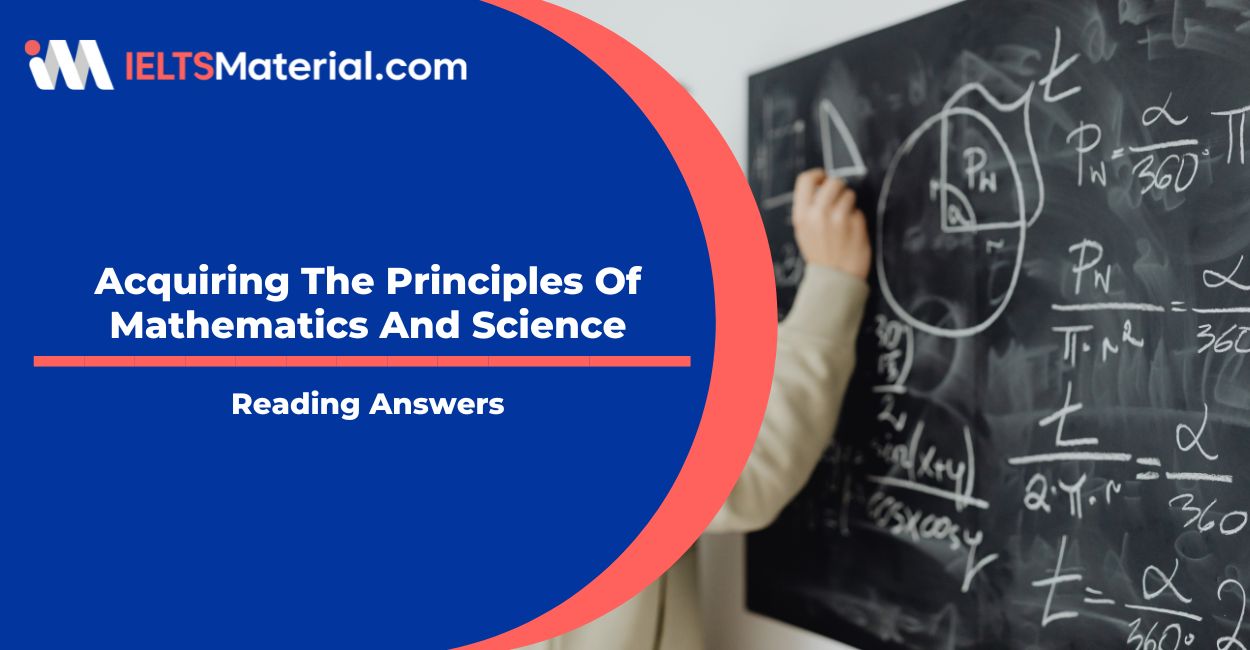Acquiring The Principles Of Mathematics And Science Reading Answers
3 min read
Updated On
-
Copy link
Table of Contents

Limited-Time Offer : Access a FREE 10-Day IELTS Study Plan!
This article contains the Acquiring The Principles Of Mathematics And Science reading answers.
Acquiring The Principles Of Mathematics And Science is a real Reading test passage that appeared in the IELTS.
With diligent practice, the Reading Module can be the top-scoring category for IELTS Aspirants. To score well, you must understand how to approach and answer the different question types in the Reading Module.
By solving and reviewing Sample Reading Questions from past IELTS papers, you can ensure that your Reading skills are up to the mark. Take the practice test Acquiring The Principles Of Mathematics And Science below and try more IELTS reading practice tests from IELTSMaterial.com.
Not sure how to answer IELTS Reading Matching Headings questions? Check out the video below to learn now!
For more Matching Headings Questions practice, take a look at IELTS Reading Tips & Practice Test: Matching Headings to Paragraphs exercises!
Acquiring The Principles Of Mathematics And Science
You should spend about 20 minutes on Questions 1-13, which are based on the Reading Passage below. Find the practice test with the Acquiring The Principles Of Mathematics And Science PDF here.
Answers
| Question number | Answer | Keywords | Location of keywords |
|---|---|---|---|
| 1 | v | in order to learn science, people often have to change the way they think in ordinary situations | Paragraph A;
Line 2 |
| 2 | ii | students may be able to repeat a formula but fail to use the concept represented by the formula when they explain observed events. | Paragraph B;
Last line |
| 3 | vi | in order for pupils to progress in their thinking they need to be actively engaged in solving problems that will challenge their current mode of reasoning | Paragraph C;
Line 5 |
| 4 | i | Piaget’s hypothesis about how cognitive change occurs was later translated into an educational approach which is now termed ‘discovery learning’. Discovery learning initially took what is now considered the Tone learner’ route. | Paragraph D;
Lines 1 – 2 |
| 5 | iv | they found no evidence to support the idea that the children worked out their new conceptions during their group discussions, | Paragraph E;
Last line |
| 6 | viii | In another study, Howe set out to investigate whether the progress obtained through pair work could be a function of the exchange of ideas. | Paragraph F;
Line 1 |
| 7 | B | When confronted with a result that challenges their thinking – that is, when faced with conflict – pupils realize that they need to think again about their own ways of solving problems, regardless of whether the problem is one in mathematics or in science. | Paragraph C;
Line 2 |
| 8 | D | Piaget also pointed out that young children do not always discard their ideas in the face of contradictory evidence. They may actually discard the evidence and keep their theory | Paragraph C;
Lines 6 – end |
| 9 | A | Howe compared the progress of 8 to 12-year-old children in understanding what influences motion down a slope | Paragraph E;
Line 2 |
| 10 | E | they created two kinds of groups according to a pre-test: one in which the children had dissimilar views, and a second in which the children had similar views. | Paragraph E;
Line 3 |
| 11 | discovery learning | Piaget’s hypothesis about how cognitive change occurs was later translated into an educational approach which is now termed ‘discovery learning’. | Paragraph D;
Line 1 |
| 12 | teacher | The role of the teacher was to select situations that challenged the pupils’ reasoning; and the pupils’ peers had no real role in this process. | Paragraph D;
Line 3 |
| 13 | peers | it was subsequently proposed that interpersonal conflict, especially with peers, might play an important role in promoting cognitive change | Paragraph D;
Line 4 |
Check More IELTS Reading Answers
| Daydreaming Reading Answers | Language Diversity Reading Answers |
| Ocean Acidification Reading Answers | The Fruit Book Reading Answers |
| The Future Of Fish Reading Answers | Biofuels Reading Answers |
Also check :
Practice IELTS Reading based on question types

Start Preparing for IELTS: Get Your 10-Day Study Plan Today!
Recent Articles

Nehasri Ravishenbagam

Haniya Yashfeen

Haniya Yashfeen

Haniya Yashfeen




Post your Comments